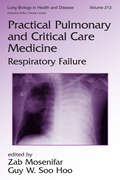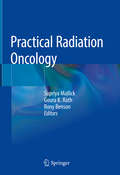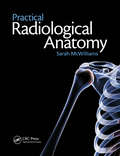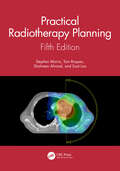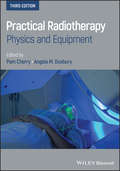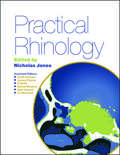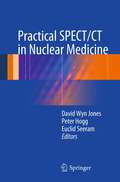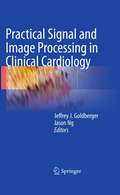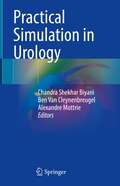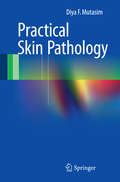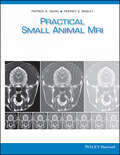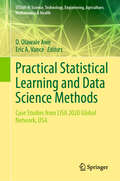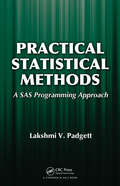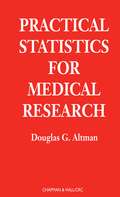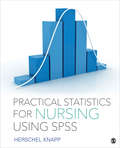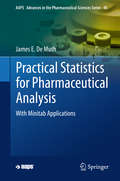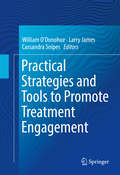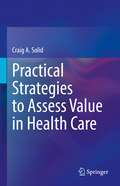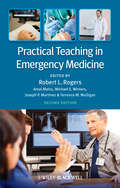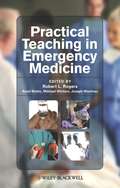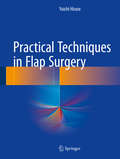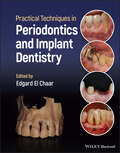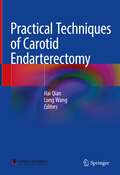- Table View
- List View
Practical Pulmonary and Critical Care Medicine: Respiratory Failure (Lung Biology in Health and Disease)
by Zab Mosenifar Guy W. Soo HooSpecifically focusing on the immediate management and diagnosis of patients in the intensive care unit, this reference contains expert reviews and practical care recommendations for patients with acute respiratory failure. Packed with detailed descriptions of treatment procedures and quality figures throughout each chapter, this reference will stan
Practical Radiation Oncology
by Supriya Mallick Goura K. Rath Rony BensonThis book addresses the most relevant aspects of radiation oncology in terms of technical integrity, dose parameters, machine and software specifications, as well as regulatory requirements. Radiation oncology is a unique field that combines physics and biology. As a result, it has not only a clinical aspect, but also a physics aspect and biology aspect, all three of which are inter-related and critical to optimal radiation treatment planning. In addition, radiation oncology involves a host of machines/software. One needs to have a firm command of these machines and their specifications to deliver comprehensive treatment. However, this information is not readily available, which poses serious challenges for students learning the planning aspect of radiation therapy. In response, this book compiles these relevant aspects in a single source. Radiation oncology is a dynamic field, and is continuously evolving. However, tracking down the latest findings is both difficult and time-consuming. Consequently, the book also comprehensively covers the most important trials. Offering an essential ready reference work, it represents a value asset for all radiation oncology practitioners, trainees and students.
Practical Radiological Anatomy
by Sarah McWilliamsAn illustrated and concise revision textbook, this book is designed for doctors training in radiology and preparing for the First FRCR exam. Using a convenient format arranged by body system, it contains high-quality images demonstrating the key features of basic anatomy. It supplies both conventional imaging and cross-sectional CT and MRI anatomy, presents guidelines on how to interpret images, includes case studies in each chapter, and discusses commonly encountered pitfalls. The text matches the current curriculum of the FRCA Part 1 and Part 2A exams.
Practical Radiotherapy Planning: Fifth Edition
by Stephen Morris Tom Roques Shahreen Ahmad Suat LooGood and effective treatment in radiotherapy requires careful consideration of the complex variables involved as well as critical assessment of the techniques. This new edition of an established classic takes into account advances in imaging and treatment delivery and reflects the current state of the art in the practice of radiotherapy, emphasizing the underlying principles of treatment that can be applied for conventional, conformal, and novel treatments.
Practical Radiotherapy: Physics and Equipment
by Pam Cherry Angela M. DuxburyNow in its third edition, Practical Radiotherapy continues to keep pace with current and emerging technologies, patient pathways, and the rapidly expanding role of therapeutic radiographers. Extensively revised and updated, this accessible book examines all the essential aspects of radiotherapy, from the physics and mathematics of radiation beams, to in-depth descriptions of the equipment used by radiotherapy practitioners, to new and expanded coverage of MR-linac and Halcyon technology, proton therapy, stereotactic body radiotherapy, sealed-source verification and quality assurance for MV equipment. Covers all the core information essential to radiotherapy practice Describes the major aspects of therapeutic radiography in a practical context Includes updated self-assessment tests, images and diagrams, supplemental reading suggestions and more radiotherapy-specific examples Features expanded coverage of legislation, advanced treatment delivery, flattening filter free treatment and more Practical Radiotherapy is a valuable resource for radiotherapy and medical physics students, radiotherapists, therapeutic radiographers, radiation therapists, clinical oncologists and oncology nurses.
Practical Rhinology
by Nicholas JonesAn ideal textbook for trainee and practising rhinologists and otolaryngologists, Practical Rhinology provides expert direction on all aspects of rhinology. This up-to-date text addresses the most pertinent aspects of contemporary rhinology and provides a distillation of the current advances in this superspecialty from several of the world's le
Practical SPECT/CT in Nuclear Medicine
by Peter Hogg David Wyn Jones Euclid SeeramNuclear Medicine is a diagnostic modality which aims to image and in some cases quantify physiological processes in the body to highlight disease or injury. Within nuclear medicine, over the past few decades, major technological changes have occurred and concomitantly changes in the knowledge and skills required have had to evolve. One of the most significant technological changes has been the fusion of imaging technologies, to create hybrid systems such as SPECT/CT, PET/CT and PET/MR. With these changes in mind, Practical SPECT/CT in Nuclear Medicine provides a handy and informative guide to the purchase, clinical implementation and routine use of a SPECT/CT scanner. Practical SPECT/CT in Nuclear Medicine will be a valuable resource for all personnel working in nuclear medicine and it will be of particular value to trainees.
Practical Signal and Image Processing in Clinical Cardiology
by Jason Ng Jeffrey J GoldbergerModern signal and image acquisition systems used in the field of cardiology acquire, analyze, and store data digitally. Surface electrocardiography, intra-cardiac electrogram recording, echocardiograms, x-ray, magnetic resonance imaging, and computed tomography are among the modalities in the cardiology field where signal processing is applied. Digital signal processing techniques allow us to automate many of the analyses that had previously been done manually with greater precision, accuracy and speed, as well as detect features and patterns in data that may be too subtle to observe by eye. As more cardiologists are becoming more reliant on such technology, a basic understanding of digital signals and the techniques used to extract information from these signals are required.
Practical Simulation in Urology
by Alexandre Mottrie Chandra Shekhar Biyani Ben Van CleynenbreugelThis book provides a detailed overview of a range of simulation models that have been developed which are applicable to urology. Chapters feature critical analysis of techniques including synthetic bench top models, computer-assisted virtual reality and box simulators. Furthermore, details of best practice, the latest innovations and guidance on how to select potential low-cost options is provided, enabling the reader to systematically develop a thorough understanding of the subject.Practical Simulation in Urology is a comprehensive resource that critically analyses the latest simulation techniques that are applicable in urology, making it an ideal resource for the practicing and trainee urologist seeking an up-to-date overview on the subject.
Practical Skin Pathology
by Diya F. MutasimThis engaging new text teaches students, residents, and practitioners of all ages how to use insights from both pathologists and dermatologists to improve their comprehension of skin disorders. It is meant to bridge the gap between dermatology and dermapathology and explores the questions that practitioners have that fall between the two subjects. What is a dermatologist to do with a pathology report that has a histological rather than a clinical diagnosis? What is to be done with old names of disorders that some clinicians still use? Why do some disorders have many names, and which is better and why? These and dozens of other questions are answered in Practical Skin Pathology, the only book of its kind to address both the clinical education of each disease as well as the pathology findings. Authored by a leader in clinical dermatology, dermatopathology, and skin immunology, Practical Skin Pathology is written for dermatologists, dermatology residents, and dermatopathologists. Addressing such questions as whether to accept a differential diagnosis from a dermatopathologist rather than a specific diagnosis and when, to how to help a pathologists give a dermatologist the best possible interpretation of a biopsy, this quick reference includes color illustrations, images, and tables to better assist the physician in answering these common questions and concerns.
Practical Small Animal MRI
by Patrick R. Gavin Rodney S. BagleyPractical Small Animal MRI is the seminal reference for clinicians using Magnetic Resonance Imaging in the diagnosis and treatment of veterinary patients. Although MRI is used most frequently in the diagnosis of neurologic disorders, it also has significant application to other body systems. This book covers normal anatomy and specific clinical conditions of the nervous system, musculoskeletal system, abdomen, thorax, and head and neck. It also contains several chapters on disease of the brain and spine, including inflammatory, infectious, neoplastic, and vascular diseases, alongside congenital and degenerative disorders.
Practical Statistical Learning and Data Science Methods: Case Studies from LISA 2020 Global Network, USA (STEAM-H: Science, Technology, Engineering, Agriculture, Mathematics & Health)
by O. Olawale Awe Eric A. VanceThis contributed volume offers practical implementation strategies for statistical learning and data science techniques, with fully peer-reviewed papers that embody insights and experiences gathered within the LISA 2020 Global Network. Through a series of compelling case studies, readers are immersed in practical methodologies, real-world applications, and innovative approaches in statistical learning and data science. Topics covered in this volume span a wide array of applications, including machine learning in health data analysis, deep learning models for precipitation modeling, interpretation techniques for machine learning models in BMI classification for obesity studies, as well as a comparative analysis of sampling methods in machine learning health applications. By addressing the evolving landscape of data analytics in many ways, this volume serves as a valuable resource for practitioners, researchers, and students alike. The LISA 2020 Global Network is dedicated to enhancing statistical and data science capabilities in developing countries through the establishment of collaboration laboratories, also known as “stat labs.” These stat labs function as engines for development, nurturing the next generation of collaborative statisticians and data scientists while providing essential research infrastructure for researchers, data producers, and decision-makers.
Practical Statistical Methods: A SAS Programming Approach
by Lakshmi PadgettPractical Statistical Methods: A SAS Programming Approach presents a broad spectrum of statistical methods useful for researchers without an extensive statistical background. In addition to nonparametric methods, it covers methods for discrete and continuous data. Omitting mathematical details and complicated formulae, the text provides SAS program
Practical Statistics for Medical Research (Chapman & Hall/CRC Texts in Statistical Science)
by Douglas G. AltmanPractical Statistics for Medical Research is a problem-based text for medical researchers, medical students, and others in the medical arena who need to use statistics but have no specialized mathematics background. The author draws on twenty years of experience as a consulting medical statistician to provide clear explanations to key statistical concepts, with a firm emphasis on practical aspects of designing and analyzing medical research. Using real data and including dozens of interesting data sets, this bestselling text gives special attention to the presentation and interpretation of results and the many real problems that arise in medical research.
Practical Statistics for Nursing Using SPSS: Knapp: Practical Statistics For Nursing Using Spss + Sage Ibm® Spss® Statistics V23. 0 Student Version
by Herschel KnappA friendly and approachable guide to real-world statistics, Practical Statistics for Nursing Using SPSS® covers the most common statistical functions in nursing science using plain language. Students learn by doing, and an emphasis on this practical approach is seen throughout the book with each chapter structured to answer key questions: What statistical test should I use for this situation? How do I set up the data? How do I run the test? How do I interpret and document the results? Practice exercises include a vignette, codebook, and data sets ready for processing, enabling students to achieve mastery by carrying out actual statistical analyses. Online resources for students are available and include data sets for examples and exercises, fully developed solutions to all odd-numbered exercises, and thorough tutorial videos providing an overview of each statistical method, step-by-step guidance on SPSS® processing, and interpretation of results. Online resources for instructors include Microsoft® PowerPoint® slides for each chapter and solutions to all exercises.
Practical Statistics for Nursing Using SPSS: Knapp: Practical Statistics For Nursing Using Spss + Sage Ibm® Spss® Statistics V23. 0 Student Version
by Herschel KnappA friendly and approachable guide to real-world statistics, Practical Statistics for Nursing Using SPSS® covers the most common statistical functions in nursing science using plain language. Students learn by doing, and an emphasis on this practical approach is seen throughout the book with each chapter structured to answer key questions: What statistical test should I use for this situation? How do I set up the data? How do I run the test? How do I interpret and document the results? Practice exercises include a vignette, codebook, and data sets ready for processing, enabling students to achieve mastery by carrying out actual statistical analyses. Online resources for students are available and include data sets for examples and exercises, fully developed solutions to all odd-numbered exercises, and thorough tutorial videos providing an overview of each statistical method, step-by-step guidance on SPSS® processing, and interpretation of results. Online resources for instructors include Microsoft® PowerPoint® slides for each chapter and solutions to all exercises.
Practical Statistics for Nursing and Health Care
by Jim Fowler Mel Chevannes Philip JarvisNow in its second edition, Practical Statistics for Nursing and Health Care provides a sound foundation for nursing, midwifery and other health care students and early career professionals, guiding readers through the often daunting subject of statistics ‘from scratch’. Making no assumptions about one’s existing knowledge, the text develops in complexity as the material and concepts become more familiar, allowing readers to build the confidence and skills to apply various formula and techniques to their own data. The authors explain common methods of interpreting data sets and explore basic statistical principles that enable nurses and health care professionals to decide on suitable treatment, as well as equipping readers with the tools to critically appraise clinical trials and epidemiology journals. Offers information on statistics presented in a clear, straightforward manner Covers all basic statistical concepts and tests, and includes worked examples, case studies, and data sets Provides an understanding of how data collected can be processed for the patients’ benefit Contains a new section on how to calculate and use percentiles Written for students, qualified nurses and other healthcare professionals, Practical Statistics for Nursing and Health Care is a hands-on guide to gaining rapid proficiency in statistics.
Practical Statistics for Pharmaceutical Analysis: With Minitab Applications (AAPS Advances in the Pharmaceutical Sciences Series #40)
by James E. De MuthThis is an introductory statistics book designed to provide scientists with practical information needed to apply the most common statistical tests to laboratory research data. The book is designed to be practical and applicable, so only minimal information is devoted to theory or equations. Emphasis is placed on the underlying principles for effective data analysis and survey the statistical tests. It is of special value for scientists who have access to Minitab software. Examples are provides for all the statistical tests and explanation of the interpretation of these results presented with Minitab (similar to results for any common software package). The book is specifically designed to contribute to the AAPS series on advances in the pharmaceutical sciences. It benefits professional scientists or graduate students who have not had a formal statistics class, who had bad experiences in such classes, or who just fear/don’t understand statistics. Chapter 1 focuses on terminology and essential elements of statistical testing. Statistics is often complicated by synonyms and this chapter established the terms used in the book and how rudiments interact to create statistical tests. Chapter 2 discussed descriptive statistics that are used to organize and summarize sample results. Chapter 3 discussed basic assumptions of probability, characteristics of a normal distribution, alternative approaches for non-normal distributions and introduces the topic of making inferences about a larger population based on a small sample from that population. Chapter 4 discussed hypothesis testing where computer output is interpreted and decisions are made regarding statistical significance. This chapter also deasl with the determination of appropriate sample sizes. The next three chapters focus on tests that make decisions about a population base on a small subset of information. Chapter 5 looks at statistical tests that evaluate where a significant difference exists. In Chapter 6 the tests try to determine the extent and importance of relationships. In contrast to fifth chapter, Chapter 7 presents tests that evaluate the equivalence, not the difference between levels being tested. The last chapter deals with potential outlier or aberrant values and how to statistically determine if they should be removed from the sample data. Each statistical test presented includes an example problem with the resultant software output and how to interpret the results. Minimal time is spent on the mathematical calculations or theory. For those interested in the associated equations, supplemental figures are presented for each test with respective formulas. In addition, Appendix D presents the equations and proof for every output result for the various examples. Examples and results from the appropriate statistical results are displayed using Minitab 18Ò. In addition to the results, the required steps to analyze data using Minitab are presented with the examples for those having access to this software. Numerous other software packages are available, including based data analysis with Excel.
Practical Strategies and Tools to Promote Treatment Engagement
by Larry James William O'Donohue Cassandra SnipesThis practice-building resource examines the psychology behind non-adherence and the importance of building commitment to treatment as the foundation of successful therapy. Coverage starts by illustrating the complex phenomena of non-adherence at different stages of intervention--including mechanisms and situations that may prevent even initial engagement. From there, experts from diverse specialties offer interest-promoting strategies tailored to specific conditions (diabetes, anxiety, depression) and populations (children, dually diagnosed patients), informed by the current knowledge base on treatment effectiveness and recent technological advances. And the editors make patient-centered recommendations for the health and mental health professions to make therapy more accessible and open. Among the topics covered: #65533; Meeting patients where they are: using a stage approach to facilitate engagement. #65533; Use of mindfulness in promoting treatment engagement. #65533; DBT and treatment engagement in the context of highly suicidal complex clients. #65533; Behavioral Problems in children: ADHD and ODD. #65533; Engagement of patients in the self-management of pain. #65533; Engaging trauma survivors in treatment. A breakthrough in the behavioral health delivery services literature, Practical Strategies and Tools to Promote Treatment Engagement offers real-world tools, guidelines, and expertise to health psychologists, primary care physicians and nurses, clinical psychologists, and clinical social workers. It is a vivid reminder that patients need not only what's good for them, but also what works for them.
Practical Strategies to Assess Value in Health Care
by Craig A. SolidThese days, the idea of “value” is at the center of many activities and decisions in health care in the United States. While there exist books that detail the technical steps for how to carry out a specific type of value assessment, such as cost-effectiveness or return on investment, there are few that attempt to teach healthcare professionals how to think about value. This book provides a deeper understanding of value as a concept as well as an endeavor (as in, to determine or uncover the value of care) within the healthcare industry by illustrating the different components of value that should guide decision-making processes for policy, infrastructure, and quality improvement. Through an exploration of theories of economics and implementation science, as well as practical suggestions for real-world applications, this text provides a foundation for the long and complicated “value” journey the US has bet its entire healthcare system on. In the US, policy to promote what is referred to as “value-based care” is here to stay. As we move forward within this construct, we need to move beyond the over-simplified definition of value as “quality per dollar spent” to a more functional framework for how to think about value that can adapt to different circumstances and points of view. Only then will it be possible to compare value across settings, conditions, and activities.The book consists of 9 chapters organized in four sections:Part I: Understanding the Challenges of Assessing the Value of Health Care Part II: A Primer on Fundamental Concepts and Current Techniques Used to Measure Value in Health Care Part III: A Discussion of the Real-world Motivations and Requirements that Should be Contemplated when Exploring ValuePart IV: How to Design and Perform a Value Assessment Practical Strategies to Assess Value in Health Care is an essential resource for healthcare professionals at all levels and points of care who are interested in understanding how best to assess and interpret value for a particular situation including providers, administrators, payers, insurers, health plans, and policy-makers.
Practical Teaching in Emergency Medicine
by Amal Mattu Robert L. Rogers Joseph P. Martinez Michael E. Winters Terrence MulliganEmergency medicine attendings who wish to hone their teaching skills can find a number of books on educational strategies written by physicians from other disciplines. However, until the publication of the first edition of this book, they did not have access to a text written by emergency medicine physicians on methods of teaching that are directly applicable to teaching EM. This book was compiled to meet that need. Following the introductory section, which provides important background information, the book's contents are organized into 4 sections that correspond to the core needs and interests of EM educators: Section 2 focuses on practical and ethical considerations of teaching in the ED; Section 3 provides strategies for teaching specific groups of learners; Section 4 looks at the skills that are characteristic of the best EM educators; and Section 5 looks indepthly at specific teaching techniques and strategies. Now more than ever this book addresses the needs of physician educators from all over the world. New chapters discuss lecturing to an international audience; using simulation as a teaching tool; how to make journal club work for you, and other topics that are of broad interest to medical educators in this field. In general, each chapter has been updated and reviewed to make sure the content was something that emergency physician educators could use in any country . The chapter contributors are widely regarded as leaders in the field of emergency medicine education and faculty development. Authors were given free rein to develop their chapters and write in their own style. They were asked to present their personal views on how to successfully teach the art of emergency medicine, rather than review evidence-based guidelines regarding medical education. As a result, most of the chapters have few references. This first-person approach to a multi-authored textbook yields a compilation that varies in style from chapter to chapter and exposes the reader to a variety of communication techniques.
Practical Teaching in Emergency Medicine
by Amal Mattu Robert L. Rogers Joseph P. Martinez Michael E. WintersInherent to the teaching and practice of emergency medicine are specific challenges not found in other specialties - the unknowns of the emergency department, the need to identify life- and limb-threatening conditions, the pressure to solve problems and find solutions quickly, and the orchestration of clinical specialists and ancillary services. Because of these unique demands, books written by clinicians from other disciplines, that extrapolate their information from other specialties, aren’t always suitable references for teachers of emergency medicine. This book is different – it shows how to incorporate effective teaching strategies into the unique teaching atmosphere of the emergency department, how to effectively lecture, lead small groups, give feedback, foster life-long faculty development skills, and much more – it is written by emergency medicine physicians for emergency medicine physicians. Practical Teaching in Emergency Medicine gets to the essential core of how to best teach the art of practicing emergency medicine – and provides the blueprint to become a better teacher, providing guidance on how to accomplish skilful teaching in busy emergency departments. It provides emergency physicians and trainees with the necessary tools to effectively and efficiently transmit information to learners in the often times chaotic emergency department environment.
Practical Techniques in Flap Surgery
by Yuichi HiraseThis book was written for orthopedic and plastic surgeons who wish to learn about reconstructive surgery of the extremities and trunk. For reconstructions of the extremities and trunk, surgeons need information on both orthopedic and plastic surgery. However, orthopedic surgeons are generally not familiar with the reconstruction of soft tissue, and plastic surgeons have little experience with osseo-tendinous system reconstructions. For those reasons, there is a definite need for a book detailing both fields of surgery. Because many existing books focus on only the type of flap, it is difficult for doctors to distinguish which flap is best for their patients in need of reconstructive surgery. In this book, chapters are based not on the flap but the injury site. In the each chapter, pitfalls and candidate flaps are described for the reconstruction of each site. Additionally, the operative steps are explained with the help of numerous high-quality photos, offering a unique valuable resource for orthopedic and plastic surgeons faced with these challenges.
Practical Techniques in Periodontics and Implant Dentistry
by Edgard El ChaarPractical Techniques in Periodontics and Implant Dentistry A quick reference to essential techniques in periodontics and implant dentistry designed for clinical use In Practical Techniques in Periodontics and Implant Dentistry, distinguished periodontist Dr. Edgard El Chaar delivers a comprehensive quick reference to key information on periodontics and implant dentistry. The book takes a concise and technique-based approach to the subject, a design that allows clinicians to rapidly find and apply important information in seeing cases. It provides brief chapters with plentiful and instructive images. This manual is precise, offers quick access to the fundamentals of each of the pertinent topics in the field, and provides practitioners the ability to refer to an authoritative and straightforward resource in their daily clinical practice. It includes radiographs, histological images, clinical photographs, and line drawings. Readers will also find: A thorough introduction to the anatomy and physiology of the periodontium, including an overview of gingival tissue, embryonic development, and soft tissue physiology Comprehensive explorations of wound healing, pathology of periodontal disease, and oral medicine and pathology In-depth discussions of patient examination and initial therapy, surgical anatomy and local anesthesia, and suturing techniques Fulsome presentations of osseous surgery, clinical crown lengthening, and the principles of implant dentistry Perfect for general practitioners, periodontists, and implant dentists, Practical Techniques in Periodontics and Implant Dentistry will also earn a place in the libraries of dental students with an interest in periodontics.
Practical Techniques of Carotid Endarterectomy
by Long Wang Hai QianThis book addresses multiple principles of carotid endarterectomy in terms of cervical anatomy, surgical techniques, practical cases and frequent questions stemming from clinical practice. Carotid endarterectomy (CEA) is an effective way to the treatment of carotid artery stenosis, which significantly reduce the risk of stroke. This book covers the key concepts and common question in CEA. It is a practical book focusing on basic surgical technical techniques, but not covers controversial issues.
